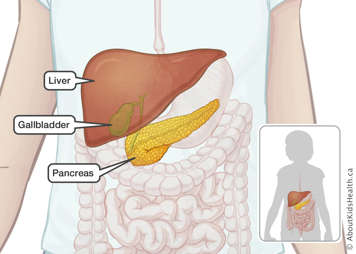The liver, pancreas and gall bladder are called accessory organs. This means they work with the
GI tract to break down food.
Liver

The liver is the largest gland in the body, weighing about 1.5 kg (3.3 lb) in an adult. The liver has many roles in the digestive system. For example, it:
- produces a green fluid called bile, which breaks down fats
- removes wastes and toxins from the body
- breaks down nutrients and stores some nutrients, vitamins and minerals.
Pancreas
The pancreas is located below the stomach. It produces a mix of enzymes that together are called pancreatic juice. Pancreatic juice also helps us to digest proteins, fats and carbohydrates. The pancreas also produces hormones that help control glucose (sugar) in the blood.
This animation shows how sugar is released in the body and turned into energy with the help of insulin. The animation is supplemental and repeats information from the text on this page.
Gall bladder
The gall bladder is a pouch-shaped organ that stores the bile produced by the liver. The gall bladder shares a vessel, called the common bile duct, with the liver. When bile is needed, it moves through the common bile duct into the first part of the small intestine, the duodenum. It is here that the bile breaks down fat.